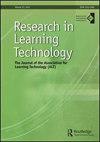预测中学生使用电子学习技术的意向
IF 1.2
Q2 EDUCATION & EDUCATIONAL RESEARCH
引用次数: 0
摘要
技术接受研究很有趣,因为它们在解释采用和使用特定技术的意图方面具有实用性和理论上的帮助。文献中有大量关于电子学习和其他技术的研究,但解释中学生使用电子学习的意图的证据有限。本研究以扩展的技术接受模型(TAM)解释中学生使用电子学习的意向。TAM是解释人们如何在不同领域采用新技术的有用理论。数据来自土耳其的2739名中学生(Mage = 11.95)。采用验证性因子分析(CFA)和结构方程模型(SEM)对概念模型进行检验。结果与原TAM模型基本一致。影响中学生使用电子学习技术意愿的最关键变量是享受。研究结果显示,不同文化背景的中学生使用电子学习技术的意愿可能存在差异。本文章由计算机程序翻译,如有差异,请以英文原文为准。
Predicting the secondary school students’ intention to use e-learning technologies
Technology acceptance studies are interesting because they are practical and theoretically helpful in explaining the adoption and intention to use a particular technology. There is a large amount of research on e-learning and other technologies in the literature, but there is limited evidence to explain why secondary school students’ intention to use e-learning. This study explains secondary school students’ intentions to use e-learning with an extended Technology Acceptance Model (TAM). TAM is a useful theory to explain how people adopt new technologies in different fields. Data were collected from 2739 secondary school students in Turkey (Mage = 11.95). Confirmatory factor analysis (CFA) and structural equation modelling (SEM) were used to test the conceptual model. The results are consistent with the original TAM model. The most critical variable affecting secondary school students’ intention to use e-learning technologies is enjoyment. The results show that there may be differences in the intention to use e-learning technologies for secondary school students in different cultures and contexts.
求助全文
通过发布文献求助,成功后即可免费获取论文全文。
去求助
来源期刊

Research in Learning Technology
EDUCATION & EDUCATIONAL RESEARCH-
CiteScore
6.50
自引率
0.00%
发文量
13
审稿时长
20 weeks
 求助内容:
求助内容: 应助结果提醒方式:
应助结果提醒方式:


